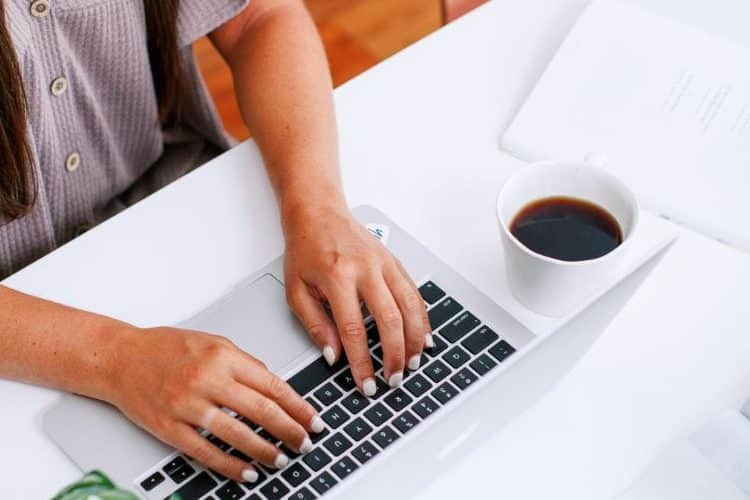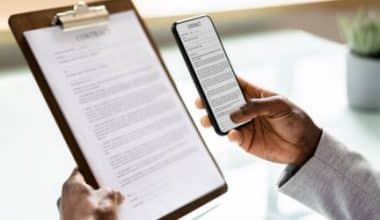It is crucial to format your email or mail as professionally as you would a business letter whether sending an inquiry about a job, applying for a job, or writing other professional correspondence. After all, everyone gets a lot of emails, including recruiters and HR managers. Make sure that the content of your emails stands out, rather than your carelessness with grammar, layout, or language. Sending a business email is a common way to get in touch with clients, employers, and other industry insiders. Different official mail format exists for various scenarios. Seeing examples of properly formatted emails might help you decide on the best style to employ in various professional contexts. Below we cover the proper letter, address, and mail format that will guide you to put up an excellent mail.
What is Email Writing?
Writing an email entails creating the message, delivering it, archiving it, and reading it later. The email refers to any form of electronic communication. Writing an email is chosen over other methods of communication since it is both time and cost-effective.
Also, Email, short for “electronic mail,” is a way to communicate digitally via the Internet and exchange messages and files. Emails are commonly used for business-related correspondence. Due to its low cost and short processing time, it has quickly become the preferred method of communication.
Letter writing has given place to email as a more contemporary means of communication due to technological advancements. However, sending an email back and forth is a crucial aspect of the modern-day conversation. This is a common means of communicating with staff in businesses, companies, etc. This is also a significant component of school curricula.
Types of Email Writing
Here are the 3 categories of email writing.
#1. Semi-Formal Email
This is the type of communication that includes an email that is written for a coworker or a teammate in the context of a project. The language that is chosen is one that is easy to understand, cordial, and informal. Also, it is essential to behave with decency and tact at all times.
#2. Formal Email
Let’s say we are engaged in the process of creating or composing an email for some kind of commercial communication. It will be considered a formal email in tone and content. A formal email is an email that is written to officers at an organization, such as a company, a government department, a school, or any other type of officer.
#3. Informal Email
An informal email is one that is written to any friends, family members, or relatives. When communicating informally by email, there is no set of guidelines to follow. A person is free to communicate in any language of their choosing.
Features of Email
An email comes with a ton of beneficial features. The following is an example of a few of them:
- In-built message-reply bot
- Add the address to your address book.
- Future use of the address is possible at this location.
- A system for filing and retrieving messages mechanically
- Reassurance that a message has been delivered
- The capability of mass communication distribution
- In order to attach signatures,
- Data-driven by the current time and date
- Files, pictures, and audio can all be delivered as attachments.
- Email that can be read on a mobile device
Mail Format
It’s crucial to learn the basics of mail writing before delving into premade templates. Each mail, regardless of its subject, will have the same general format and the same features. Learning these aspects can help you write more professional and persuasive emails.
What Is the Proper Email Format?
The proper format of mail consists of a subject line, greeting, body, closing line, and signature. When crafting an email, it’s important to keep a few things in mind: a short subject line, a customized welcome, simple language, and a fitting closing line and signature.
Use an email template to help you arrange your message so that it speaks directly to the needs and interests of the receiver. While the structure of emails can vary, the goal of each is the same: to convey the message that was intended to be sent.
Thus, let’s discuss what makes for a decent email format and how to implement it in your own correspondence.
#1. Subject Line
The email’s receiver will see the subject line before anything else. Consequently, the first crucial aspect of formal email writing is the subject line.
Some considerations are as follows:
- Make sure the subject line is clear and concise.
- A concise subject line is preferable. The perfect length for a subject line is six words.
- Also, use the first few characters of the subject line to convey the most relevant information.
- To refine your search even more, add a prefix such as “Forward,” “Reply,” “Urgent,” or “Notice.” It lets the recipient know what kind of email they’ve received.
According to research, an e-mail with a personalized subject line has a 26% higher chance of being opened. Whether you’re sending a sales email, a personal email, a newsletter, or something else, the subject line should reflect the purpose of the email. I would suggest sitting down and giving some serious thought to your options before settling on one.
#2. Salutation
The salutation is the next important part of an official mail format. Each and every email has a specific recipient in mind. The first step in writing a formal email is to address the recipient appropriately.
Use “To Whom It May Concern” or “Dear Sir or Madam” when writing to someone whose name you do not know.
Senior officials should be addressed as “To the Manager,” “Dear Dr. Ghosh,” or “Dear Ms. Kim,” rather than using their first name.
It could be sufficient to merely say “Hi” before a coworker’s name when addressing them. Always be polite and remember to use a proper greeting. In a business email, you should always use a full name, not simply a first or last name.
#3. Body of the Email
The main part of any business email is the body text. A standard format for professional mail can be achieved by adhering to a few simple guidelines.
- The first paragraph of your email should introduce yourself and the purpose of your message. If you don’t know the recipient, start with an introduction and a note explaining why you’re writing.
- Provide as much detail as you can about your issue, question, or answer. Use simple language that anyone can grasp, but don’t digress from the main topic by including irrelevant details. Be brief and to the point.
- The email’s final sentence should reflect the serious tone and proper structure of the entire message. while asking a question, you might say something like, “I look forward to hearing from you soon,” or “I hope to have a response from you soon,” and while answering a question, you can say something like, “I hope I have sufficiently answered your query/doubts.”
#4. Signature
Your email signature (sometimes called a footer) serves as a farewell. The manner in which you carry this out will have a bearing on the impression you have made thus far. This is your chance to impress your reader and earn their praise by making the experience one they won’t soon forget. However, if you make a mistake here, your entire message or offer could be questioned. You should take care to ensure that your email signature is neat and well-organized.
Furthermore, if you want to make a good first and lasting impression, you should think about making a professional email signature. The standard text-only email signature from the early days of email is at your disposal. In either case, make sure to list all of your relevant work and contact details. It’s also a good idea to include clickable links to your main website, your most active social media profiles, and a landing page.
5 Mail Format With Examples
Here, we’ll go over the five most common kinds of mail and the ideal format for each one:
#1. Professional Mail Format
Business-related emails are always written in a formal tone. A freelancer’s initial contact with new clients, for instance, should be conducted via a businesslike email. In today’s environment, it’s important for these emails to be tailored to the individual recipient.
Here is the proper format for a business mail:
- Create an engaging subject line and tailor it to each individual reader.
- Determine the appropriate greeting based on your familiarity with the receiver.
- Start the email by explaining who you are and why you’ve decided to contact this person. Establish rapport before making a sales pitch.
- Finish the email with a succinct call to action and a businesslike signature.
Here is an excellent example of a business email that uses a cheerful, inviting tone and an immediate greeting of the receiver by name.
Hi Paul,
I’m Kyrian, and I’m in charge of sales here at ABC Company. I’d want to talk to you about your account.
I’m pleased to inform you that several current sales will end in the coming week. Let me know if there’s a good time for us to talk.
Best wishes, Kyrian
#2. Thank You Mail Format
An email of gratitude is typically sent after some sort of interaction has taken place. The recipient may have helped you with a project, responded to a personal request you sent, been interviewed by you, or even just agreed to meet with you.
Don’t waste the recipient’s time with a drawn-out “thank you” email; instead, go right to the point. Additionally, “thank you” emails aren’t always necessary and can sometimes just clog the inbox of someone who could be incredibly busy, so think carefully about whether or not sending one will be good for you.
Here is the proper thank you mail format.
Hi [name]
Many thanks for [what they did]. It was a delight to collaborate with you, and I eagerly forward to our next chance to do so.
If there is anything else I can help you with, please don’t hesitate to get in touch.
All my best,
Name: (Official Title)
#3. Reminder Mail Format
Whether this is your first, second, or third time corresponding with this person via mail, the format of your message should change accordingly. There are necessary pieces of information to include in your first email of contact.
You don’t have to give a lot of background information in a follow-up or reminder mail. Instead, gently and briefly remind the other party of what was previously agreed upon (on the assumption that it may have been forgotten or relegated to the bottom of their to-do list).
This extra prod can help you get things done faster and in the order that matters most to you. Furthermore, the vast majority of people value your consistency and respect you more for the reminder.
Here is the proper reminder mail format example
Hi [name],
This email serves only as a friendly reminder that you have an interview scheduled with [name], who is applying for [name of role].
The meeting time and place for the interview are [time] [day] [place].
If there is anything I can do to help you get ready to interview this person, please let me know.
Best,
[Your name]
#4. Apology Mail Format
It’s human nature to err and to be incorrect occasionally. It’s inevitable that we’ll make mistakes that will hurt, inconvenience, or frustrate other people. Also, it’s usually the best course of action to just apologize and move on.
If you sincerely apologize, the other person won’t take offense at all. Sincere apologies are always the best policy.
However, when apologizing, it is important to use words that show compassion for the person you are sorry too, rather than words that reveal your true feelings. Do not blame them, and offer no justifications.
Here is the proper apology mail format example
To Whom It May Concern:
On behalf of [company or business name], I sincerely apologize for the service we provided during your recent visit to our eatery.
I appreciate you alerting me to these problems and rest assured that we are doing all in our power to address these concerns and prevent such occurrences in the future.
Please take this $100 gift card to be used at your convenience at our restaurant in the future as our sincere apologies.
I look forward to seeing you again at [insert company or organization name] soon.
Sincerely yours,
(Insert your name and title here)
#5. Request Mail Format
Request mails are typically short and to the point, with the sender directly addressing the recipient with a request. It might be anything from seeking a meeting to connecting on a business network or even asking for a professional introduction. When responding to a request made via email, the recipient has the option of saying “yes” or “no.” However, always specify exactly what you need in an email of this nature.
Sick leave mail format
Hi [Supervisor’s Name],
I am writing to ask for time off work due to illness between [dates]. In order to recover from surgery, my doctor has advised that I take two weeks off of work. On [date], I plan to make my return to the office.
If you have any further inquiries, feel free to contact me.
Regards,
Name Here
How to Improve Your Email Writing Skills
Here are some suggestions to help you become a better mail writer:
#1. Install a Spelling and Grammar Checker
There are add-ons you can install on your computer that will check your emails for problems like spelling, grammar, and inefficient wording. These add-ons might be helpful in finding mistakes in your work that you may have missed when proofreading and making rapid corrections. Extensions can be useful, but you should be wary of the advice they provide. Instead of depending solely on a spell-checking program or a browser plugin, be sure to read over your writing yourself.
#2. Read Over Your Work for Mistakes
Proofreading your email before hitting the send button might help you catch any grammatical or stylistic mistakes. If you rewrite any part of your email, you should pay special attention to the sentences you just rewrote when reviewing your work. It’s not uncommon for folks to leave out phrases or repeat words when writing. It’s a good idea to have a second pair of eyes look at any email you’re about to send to a high-profile business associate or contact.
#3. Correct Typical Errors in Grammar and Spelling
If an add-on keeps suggesting the same thing, or you know you make silly grammar mistakes frequently, brush up on the rules of good writing to improve your skills. The misuse of your, their, and so is a common error. In addition, when you know what to look for, it’s much easier to spot errors in your own work.
#4. Take Your Writing Slowly
Even when you’re in a hurry to answer a mail, taking your time will end up saving you time in the long run. You should not rush to answer an email, as doing so can cause you to miss vital details. More time might be spent writing emails to clear up confusion or rectify misunderstandings. If you slow down, you can make sure your message gets across clearly.
Letter Mail Format
Even if SMS and emails are more popular than ever before, it’s still necessary to know how to properly address a letter. Formal letters are still used today, notably for business correspondence and when applying for jobs. Cover letters are often the initial point of contact between a potential employer and an applicant, so it’s important to make a good impression.
Therefore, the mail letter format needs to include the correct sender and date information, salutations, and an address for the intended recipient. Mastering the art of proper letter etiquette sets the tone for the entire communication and leaves a lasting impression on the recipient. Also, read OFFICIAL LETTER FORMAT: What are the Best Formats for Any Business?
Things to Include When Addressing a Formal Letter Mail Format
It’s important to keep a few guidelines in mind while writing a business or professional letter to ensure that your message is received in the best possible light. The correct mail letter-writing format is as follows:
#1. Contact Details Are at the Top
The recipient of your letter should know who you are, what your title is, where you work, and where you live, as well as where to send a reply. The sender’s details should look like this:
- First line: Full name
- Second line: Company name
- Third line: Street address
- The fourth line: City or town, followed by the state name and zip code. The state name can be abbreviated to its official postal two-letter abbreviation.
- The address should appear under the sender’s name and should be aligned to the left.
- If you are writing to someone in another country, put the name of the country in the fourth line.
- Include an email address and phone number for easier communication.
#2. Date
Next, in either the left or right margin, type the date the letter was sent. Use letters to spell out the month and digits to denote the day and year. The date could be written in a variety of formats, such as October 15, 2020.
#3. Name and Address of Recipient
This data is located on the left side of the page, below the sender’s address. The recipient’s name and postal address are included. This shows that you have taken the time to get to know the receiver and will help you form a stronger bond with them. In addition, include the recipient’s position or academic accomplishments.
For an English professor, you should address the letter to “Paul Jones, Ph.D.” The business name should go on the second line beneath the name. On the third line, include the recipient’s street and city; on the fourth, include the state and zip code. On the fourth line, write the name of the country if the recipient lives outside of the United States.
#4. Salutations
Skip one line after the addressee’s name and write the greeting instead. Whether you use a formal or informal salutation depends on how well you know the letter’s addressee. If you’ve never met the receiver before, it’s best to start with “Dear,” the most common greeting. After the greeting comes the addressee’s name, which is followed by a colon or comma.
Use “Dear Sir or Madam” followed by a colon if you are unsure of the recipient’s gender. If the addressee is a woman and you do not know whether or not she is married, use “Ms.” as the salutation. Doctor, Professor, and Honorable are just as formal as any other title. These are some examples of greetings:
- Dear Mr. Paul
- Dear Ms. Williams
- Dear Dr. Adams
- Dear Professor Mark
How Do You Write Mail?
Email is the most trusted and formal method of communication despite the proliferation of other channels. Email is used everywhere, unlike social networking or messaging apps. Because of this, email has become one of the most popular methods of business communication. As more and more businesses use a hybrid model in which some employees work from centralized remote offices and some from home, the proportion of business communications conducted via email has skyrocketed. Business email is still regarded as professional and sophisticated, in contrast, to chat and comments in team collaboration software, which can be direct and even a little bit informal. As an asynchronous channel, it ranks among the most significant ones. In addition, the email can be received, read, understood, and responded to by the intended recipients. Here is step by step to write a decent mail.
- Maintain a professional online identity.
- Use a subject that is easily comprehensible.
- Kick things off with a cheery hello.
- Provide some context
- Give the point in a nutshell.
- Bring up the CTA.
- Insert summarizing remarks
- Sign with a valid signature only.
- Check for typos, grammar mistakes, and sanity.
- Mind your CC/Bcc settings
- Always use the same mail format.
Mail Format Envelope
Postal mail and package delivery are common means of long-distance communication and shipment. Learning how to properly address an envelope is a necessary skill and format for sending and receiving mail. However, letters and packages are more likely to reach their destination and receive a response if the correct address and other details are included.
Furthermore, the recipient’s address and your own are the two most important pieces of information to mention when addressing an envelope. There are normally three lines available for the address of a personal letter: the recipient’s name, the street address, and the city, state, and ZIP code. It is common practice to include the company name, the department or recipient’s name, the street address, and the city, state, and ZIP code on separate lines when mailing a letter to a business. Here is a mail format envelope.
(Top left corner)
[Your full name]
[Your street number and name]
[Your city, state, and ZIP code]
(Center middle of an envelope)
[Recipient Name]
[Business’s name (if applicable)]
[Recipient street number and name]
[Recipient city, state, and ZIP code]
Conclusion
An email or a mail format is similar to that of a letter in that it begins with an acknowledgment of the reader, then presents the ideas at hand, and then closes with a call to action. By following best practices for email layout, you can grab the attention of your readers, motivate them to take action, and provide them with clear channels of communication with you.
However, the greatest email formats aren’t something you have to stick to religiously.
Mail Format FAQs
What Is the Most Formal Way to Start a Letter?
The standard greeting for formal letters is “Dear,” followed by the addressee’s name. Either first name and last name or first title and last name is acceptable. However, if you are unsure of the recipient’s name, “Dear Sir or Madam,” is the appropriate salutation to use.
How Do You Start and End an Email?
Here is how to start and end an email.
- Dear. If you are unfamiliar with this person before, it is best to stick to this safe, official, and polite form of address.
- Hello. The greeting “hello” combines courtesy, formality, and friendliness.
- The informal “hi” is acceptable.
- Sincerely yours.
- Regards and best wishes.
- Warmest regards.
Similar Articles
- DIRECT MAIL MARKETING: Everything You Need to Know!!!
- EMAIL SYSTEMS FOR BUSINESS: 17+ Best Picks in 2023
- STANDARD MAIL: How Long Does Standard Mail Take
- HOW TO WRITE A PROFESSIONAL LETTER: Free Guide & Tips To Know
- WEBSITE DESIGNERS SAN FRANCISCO: 10 Web Design Agencies in San Francisco 2023
- CALIFORNIA DEPARTMENT OF REHABILITATION: 2023 Review






